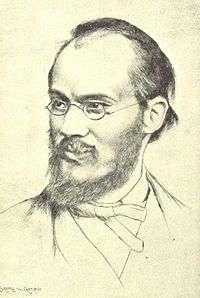Édouard Claparède
| Édouard Claparède | |
|---|---|
|
Édouard Claparède | |
| Born |
24 March 1873 Geneva |
| Died |
29 September 1940 (aged 67) Geneva |
| Residence | Geneva |
| Nationality | Switzerland |
| Fields | neurology |
| Institutions | Rousseau Institute |
| Alma mater | University of Geneva |
Édouard Claparède (24 March 1873 – 29 September 1940) was a Swiss neurologist, child psychologist, and educator.
Career
Claparede studied science and medicine, receiving in 1897 an MD from the University of Geneva, and working 1897–98 at La Salpêtrière hospital in Paris. In 1901 he founded the Archives de psychologie with his cousin, Théodore Flournoy,[1] which he edited until his death. He was based from 1904 onward at the University of Geneva, where he became director of the experimental psychology lab.[2]
Among the positions he held were: 1904 General Secretary at the Second International Congress of Psychology; 1909 General Secretary at the Sixth International Congress of Psychology; 1912 founder of the Rousseau Institute; 1915-1940 professor of psychology at the University of Geneva in succession to Flournoy; Permanent Secretary at the International Congress of Psychology; Life President of the Comité de l'Association Internationale des Conferences de Psychotechnique.
Lev Vygotsky published an important review of visual agnosia.[3] He also worked on infant psychology and teaching, and forms an important link between Jean-Jacques Rousseau's views and the stage theories of Jean Piaget in those fields.[4]
He was married to Hélène Spir, daughter of the Russian philosopher African Spir.
Trauma experiment
Claparède performed an influential experiment demonstrating how the trauma of a painful event could be retained even if short term memory was lost.[5] His experiment involved a woman who suffered from a form of amnesia. She had all of her old memories as well as her basic reasoning skills, but the recent past was not remembered. Claparède had greeted her every day, each time she could not remember his face at all. Then during one session of the experiment, Claparède hid a pin in his hand and reached to shake the woman's hand, pricking her. The next day, sure enough, she did not remember him. But when Claparède went to shake her hand, he found that she hesitated, recognizing a threat when her memory had been severely damaged.[6]
Freudianism
Claparède was briefly a member of the Zurich Freud Group marshalled by C. G. Jung,[7] but he shunned what he saw as the movement's dogmatism, and in 1909 joined Pierre Janet in differentiating the clinical concept of the subconscious from what was termed Freud's philosophical concept of the unconscious.[8] However he retained an interest in psychoanalysis in general, and in 1926 provided an introduction to the first French translation of Freud's Five Lectures on Psycho-Analysis.[9]
Works
- L’association des idées (1903)
- Psychologie de l’enfant et pédagogie expérimentale (1909)
- L’éducation fonctionnelle (1931)
- La genèse de l’hypothèse (1933)
See also
References
- ↑ R. Gregory ed., The Oxford Companion to the Mind (1987) p. 149
- ↑ R. Gregory ed., The Oxford Companion to the Mind (1987) p. 149
- ↑ R. Gregory ed., The Oxford Companion to the Mind (1987) p. 149
- ↑ J. R. Morss, The Biologising of Childhood (1990) p. 55-7 and p. 98
- ↑ Claperede's Pinprick Experiment
- ↑ R. Gregory ed., The Oxford Companion to the Mind (1987) p. 21
- ↑ Ernest Jones, The Life and Work of Sigmund Freud (1962) p. 331
- ↑ F. McLynn, Carl Gustav Jung (1996) p. 154
- ↑ E. Ewin ed., Freud Encyclopedia (2002) p. 471
Further reading
- Eustache, F.; Desgranges, B.; Messerli, P. (1996). "Edouard Claparède and human memory". Revue neurologique. 152 (10): 602–610. PMID 9033952.
- Boake, C. (2000). "Édouard Claparède and the Auditory Verbal Learning Test". Journal of Clinical and Experimental Neuropsychology (Neuropsychology, Development and Cognition: Section A). 22 (2): 286–292. doi:10.1076/1380-3395(200004)22:2;1-1;FT286. PMID 10779842.
External links
- Short biography, bibliography, and links on digitized sources in the Virtual Laboratory of the Max Planck Institute for the History of Science
